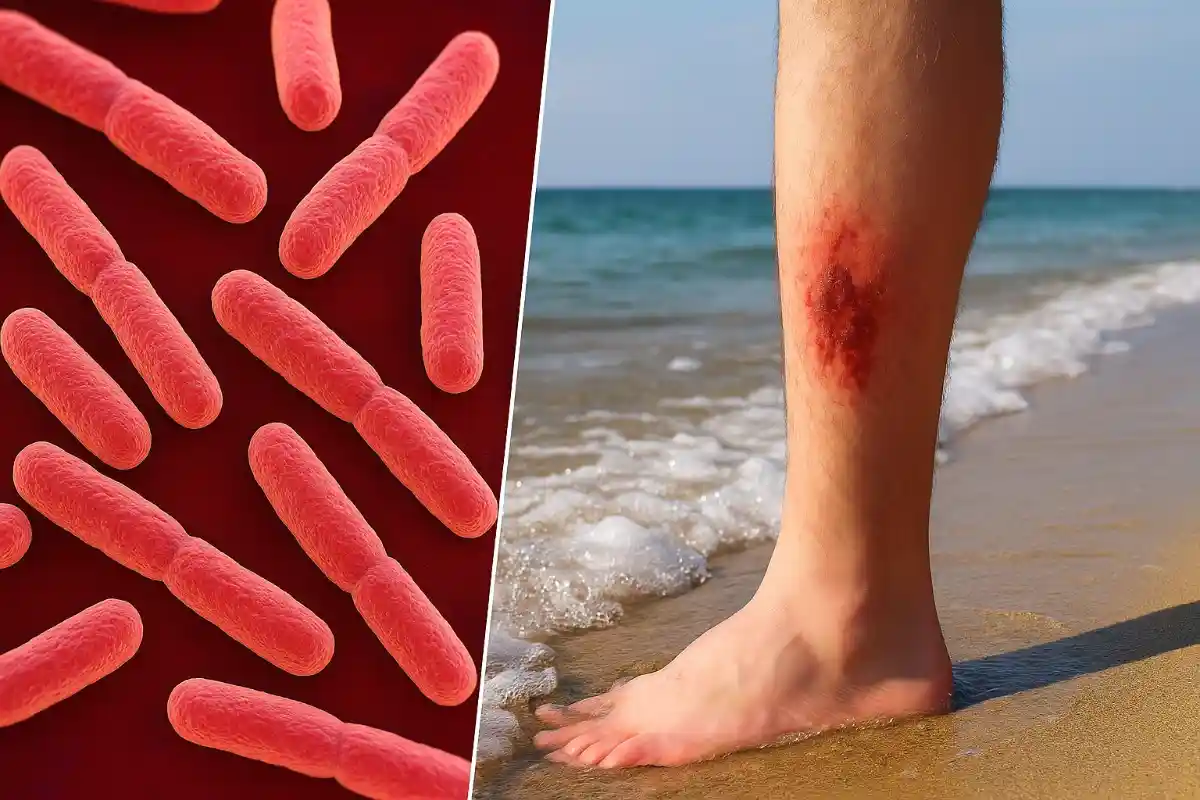Introduction
In 2025, the state of Florida is facing a growing health concern with a rise in Vibrio vulnificus infections. This is a deadly form of carnivorous bacteria found in warm coastal waters and raw seafood such as oysters. This dangerous outbreak of Vibrio vulnificus in Florida has led to multiple hospitalizations and even deaths, prompting serious public health warnings to be issued. This bacterium can enter the body through open wounds or the consumption of contaminated seafood, rapidly attacking soft tissue and potentially causing septic shock or death. With rising temperatures and increased coastal activity, understanding the spread of Vibrio vulnificus and how to prevent it is now more important than ever.
1. What is Vibrio vulnificus?
Vibrio vulnificus is a dangerous carnivorous bacterium commonly found in very warm, salty water and seafood, especially raw oysters. Vibrio vulnificus infection occurs when the bacterium enters the body through open wounds or the consumption of contaminated seafood. The bacterium rapidly damages tissues and can be life-threatening, especially for people with weakened immune systems or liver diseases. A recent Vibrio vulnificus outbreak in Florida has brought the infection to the center of public health concerns.
CDC on Vibrio vulnificus2. Flesh-Eating Bacteria Symptoms
Early recognition of the flesh-eating bacteria symptoms is vital for timely treatment of a Vibrio vulnificus infection. Common symptoms include muscle aches, fever, vomiting, and severe redness or swelling at the site of infection. In severe cases, the skin turns black due to tissue death, called necrotizing fasciitis. If not treated quickly, the infection can spread to the bloodstream, leading to septic shock and potentially death. Awareness of the symptoms of these flesh-eating bacteria is important, especially during the ongoing Vibrio vulnificus outbreak in Florida.
3. Transmission of Vibrio vulnificus
Vibrio vulnificus infection is spread primarily by coming into contact with contaminated seawater or eating raw or undercooked seafood such as oysters. Open wounds or sores caused by exposure to warm coastal waters allow the flesh-eating bacteria to enter the body. People with weakened immune systems, liver problems, or diabetes are at higher risk of severe infection. Understanding the mode of transmission of Vibrio vulnificus helps in taking necessary precautions, especially in areas affected by the Florida outbreak.
4. Impact of the Vibrio vulnificus Outbreak in Florida
The Vibrio vulnificus outbreak in Florida this time has resulted in increased hospitalizations and mortality, particularly in coastal communities. Florida’s warm waters and seafood consumption habits create an ideal environment for the flesh-eating bacteria to thrive. Local health officials and the CDC have issued warnings and safety guidelines to reduce the risk of infection. This outbreak highlights the urgent need for public awareness of Vibrio vulnificus infection and its dangers.
5. Treatment for Vibrio vulnificus Infection
Early medical intervention is crucial in treating Vibrio vulnificus infections. All doctors prescribe strong antibiotics to combat the flesh-eating bacteria, and in severe cases, surgical removal of infected tissue may be necessary. If treatment is delayed, the infection can progress rapidly, leading to serious complications or even death. Awareness of treatment options during the Vibrio vulnificus outbreak in Florida can save lives.
6. Signs and Diagnosis of Vibrio vulnificus Infection
Early recognition of the symptoms of Vibrio vulnificus infection can prevent serious consequences. Symptoms such as excessive redness of the skin, swelling, pain, and blisters or ulcers should never be ignored. Laboratory tests, including wound cultures and blood tests, confirm the presence of flesh-eating bacteria. Prompt diagnosis and treatment are essential, especially in times of increased risk such as the ongoing outbreak in Florida.
7. Fatal Cases Linked to Vibrio vulnificus
The seriousness of Vibrio vulnificus infection is evident by its high mortality rate. In bloodstream infections, mortality can reach 50%. A recent Vibrio vulnificus outbreak in Florida has unfortunately resulted in several deaths, particularly in vulnerable groups such as people with liver disease and weakened immune systems. Public health officials emphasize the importance of prevention and prompt medical care to reduce deaths from this dangerous flesh-eating bacteria.
8. Vibrio vulnificus in Seafood
Raw or undercooked seafood, especially oysters, is a common source of Vibrio vulnificus infection. Flesh-eating bacteria can survive in seafood, making their consumption risky, especially for high-risk individuals. If cooked properly, the bacteria are killed, making the seafood safe to eat. This outbreak in Florida has led to increased monitoring of seafood safety and stricter guidelines for preventing Vibrio vulnificus infection from seafood sources.
9. How to Prevent Vibrio vulnificus Infection
Simple but effective measures are important to prevent Vibrio vulnificus infection. Avoid eating raw or undercooked seafood, especially oysters. Protect open wounds from exposure to seawater, especially in affected areas such as Florida. Practice good hygiene and seek prompt medical attention if you develop signs of infection. During this serious outbreak of Vibrio vulnificus, these prevention strategies are vital to reduce the risk of this flesh-eating bacterial infection.
10. Florida Flesh-Eating Bacteria Cases Overview
The increase in cases of flesh-eating bacteria in Florida has raised concerns among healthcare providers and residents. This increase is associated with environmental factors such as warm coastal waters and seafood consumption habits in the region. Health officials are actively monitoring and managing this outbreak to protect public health. Awareness of the situation and following safety tips are vital to prevent the spread of Vibrio vulnificus infections in Florida.
11. Vibrio vulnificus Bacteria in Coastal Water
The presence of Vibrio vulnificus bacteria in warm coastal waters is a known risk factor for infection. People with open wounds exposed to these waters are at risk of developing flesh-eating bacterial infections. During the outbreak in Florida, it is extremely important to avoid exposure to seawater if you have any cuts or skin problems. Understanding the role of coastal water pollution helps to effectively prevent Vibrio vulnificus infection.
12. What is Vibrio vulnificus bacteria?
Vibrio vulnificus is a type of bacteria found in marine environments and causes serious infections classified as flesh-borne diseases. Although it may not affect healthy individuals as severely, it is quite risky for those who already have health problems. This bacterium quickly invades soft tissues and causes extensive damage. The ongoing outbreak in Florida has again drawn attention to the threat posed by Vibrio vulnificus bacteria.
13. Prevention of Vibrio vulnificus Infection
Preventive measures against Vibrio vulnificus infection are extremely important, especially in outbreak areas. Avoiding raw seafood, covering wounds, and maintaining personal hygiene can reduce the risk. During the Vibrio vulnificus outbreak in Florida, healthcare providers are emphasizing public awareness to reduce infection. Simple steps can save lives and prevent the spread of this aggressive flesh-eating bacterium.
14. Danger Posed by Vibrio vulnificus
The danger of Vibrio vulnificus lies in its rapid progression and ability to cause septic shock. This flesh-eating bacteria can cause a fatal infection if not diagnosed and treated early. This outbreak in Florida is a reminder of the serious health risks of this bacteria. Being aware and vigilant is the best defense against Vibrio vulnificus infection.
15. Rash Symptoms from Vibrio vulnificus Infection
One of the key signs of Vibrio vulnificus infection is a painful rash that occurs near the site of infection. The rash quickly worsens, and blisters and ulcers develop on the skin. Early recognition of these rash symptoms during the Florida outbreak may lead to prompt medical intervention and better outcomes against this flesh-eating disease.
16. Vibrio vulnificus Infection from Sea Water
Contact with contaminated seawater is a common source of Vibrio vulnificus infection. Open wounds or cuts can allow the flesh-eating bacteria to enter the body, causing serious infection. During outbreaks in Florida, it is strongly advised to avoid swimming in coastal waters with wounds to avoid infection.
17. Vibrio vulnificus and Raw Oysters
Raw oysters are a known carrier of Vibrio vulnificus infection because they can harbor the bacteria without showing any symptoms. During the outbreak in Florida, eating raw oysters greatly increases the risk of contracting this flesh-eating bacteria. Proper cooking is essential to kill the bacteria and ensure seafood safety.
18. Antibiotics Treatment for Flesh-Eating Bacteria
Treatment of Vibrio vulnificus infection involves powerful antibiotics that target the flesh-eating bacteria. Early administration of antibiotics increases survival rates. In severe cases, surgery is necessary to remove infected tissue. Awareness of treatment protocols during the outbreak in Florida is critical to an effective medical response.
Urgent 2025 Measles Warning: Signs & Protection





